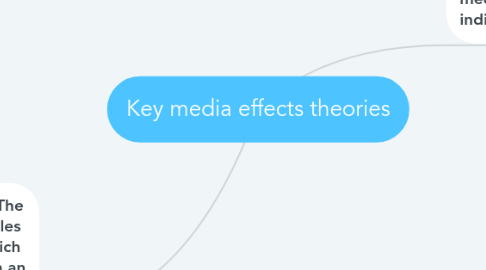
1. Micro-level media effects. The following are salient examples of media effects studies which examine media influence on individuals.
1.1. Third-person
1.1.1. Individuals often mistakenly believe that they are less susceptible to media effects than others. About fifty percent of the members in a given sample are susceptible to the third-person effect, underestimating their degree of influence. This can allow an individual to complain about media effects without taking responsibility for their own possible effects.[clarification needed][30] This is largely based on attribution theory, in which "the person tends to attribute his own reactions to the object world, and those of another, when they differ from his own, to personal characteristics/ Standley (1994) tested the third-person effect and attribution theory, reporting people are more likely offer situational reasons for television's effect upon themselves, while offering dispositional reasons for other members of an audience.
1.2. Priming
1.2.1. This is a concept derived from a network model of memory used in cognitive psychology. In this model, information is stored as nodes clustered with related nodes by associated pathways. If one node is activated, nearby nodes are also activated. This is known as spreading activation. Priming occurs when a node is activated, causing related nodes to stand by for possible activation. Both the intensity and amount of elapsed time from the moment of activation determine the strength and duration of the priming effect
1.3. Social learning
1.3.1. Miller and Dollard (1941) pioneered social learning theory with their finding that individuals do not need to personally act out a behavior to learn it; they can learn from observation. Bandura (1977) expanded upon this concept, stating that audiences can learn behaviors from observing fictitious characters
1.4. Media violence
1.4.1. The effects of media violence upon individuals have many decades of research, starting as early as the 1920s. Children and adolescents, considered vulnerable media consumers, are often the target of these studies. Most studies of media violence surround the media categories of television and video games.
2. Macro-level media effects. The following are salient examples of media effects studies which examine media influence on an audience aggregate.
2.1. Cultivation
2.1.1. Not all media effects are instantaneous or short-term. Gerbner (1969) created cultivation theory, arguing that the media cultivates a "collective consciousness about elements of existence." If audiences are exposed to repetitive themes and storylines, over time, they may expect these themes and storylines to be mirrored in real life.
2.2. Agenda setting in the news
2.2.1. There are two primary areas of media agenda-setting: (i) the media tells us the news and (ii) the media tells us what to think about the news. Press coverage sends signals to audiences about the importance of mentioned issues, while framing the news induces the unsuspecting viewer into a particular response. Additionally, news that is not given press coverage often dissipates, not only because it lacks a vehicle of mass communication, but also because individuals may not express their concerns for fear of being ostracized. This further creates the spiral of silence effect.
2.3. Framing
2.3.1. News outlets can influence public opinion by controlling variables in news presentation. News gatherers curate facts to underscore a certain angle. Presentation method—such as time of broadcast, extent of coverage and choice of news medium—can also frame the message; this can create, replace, or reinforce a certain viewpoint in an audience. Entman (2007) describes framing as "the process of culling a few elements of perceived reality and assembling a narrative that highlights connections among them to promote a particular interpretation." Not only does the media identify supposed "causes of problems," it can also "encourage moral judgments" and "promote favored policies."
2.4. Spiral of silence
2.4.1. Individuals are disinclined to share or amplify certain messages because of a fear of social isolation and a willingness to self-censor. As applies to media effects studies, some individuals may silence their opinions if the media does not validate their importance or their viewpoint. This spiral of silence can also apply to individuals in the media who may refrain from publishing controversial media content that may challenge the status quo
2.5. Limited effects theory
2.5.1. According to Lazarsfeld' s research in the 1940s, the mass media is not able to change strongly-held attitudes held by most people, as contrary to the popular beliefs. This theory suggests that viewers are selective media messages in accordance with their existing worldviews. The use of mass media simply reinforce these concepts without easily changing their opinion, or with negligible effects because well-informed people are heavily leaned on personal experience and prior knowledge.
2.6. The Dominant Paradigm
2.6.1. This theory suggests that the mass media is able to establish dominance by reflecting the opinion of social elites, who also own and controls it, described by sociologist Todd Gitlin as a kind of "importance, similar to the faulty concept of power". By owning, or sponsoring particular medium, the elites are capable to alter what people perceived from the use of mass media.
2.7. Features of current studies
2.7.1. After entering the 21st century, the rapid development of the Internet and Web 2.0 technology is greatly reforming media use patterns. Media effects studies also are more diverse and specified. After conducting a meta-analysis on micro-level media effects theories, Valkenburg, Peter & Walther (2016) identified five main features:[

